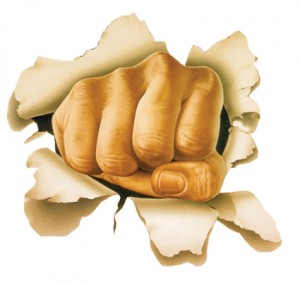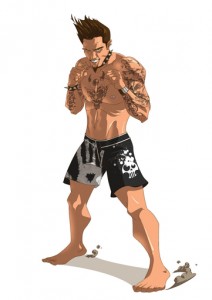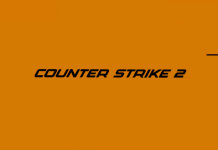 Both eyes are locked on target. Fists are clenched. The two fighters and one referee take the centre of the ring. Round one begins, with two more to follow. The fighters give it all they’ve got – grappling, punching, kicking and wrestling their way through the round. The crowd cheers as one of the fighters takes the other down. And, then suddenly there is one left standing– the winner of the evening. The crowd applauds again. Mixed martial arts (MMA), a raging spectactor sport worldwide, has taken India by storm and how!
Both eyes are locked on target. Fists are clenched. The two fighters and one referee take the centre of the ring. Round one begins, with two more to follow. The fighters give it all they’ve got – grappling, punching, kicking and wrestling their way through the round. The crowd cheers as one of the fighters takes the other down. And, then suddenly there is one left standing– the winner of the evening. The crowd applauds again. Mixed martial arts (MMA), a raging spectactor sport worldwide, has taken India by storm and how!
The dope on MMA
Mixed martial arts is a full-contact combat sport that combines the use of different fighting techniques, ranging from a mixture of martial arts traditions as well as non-traditions. It allows the use of grappling and striking techniques, both standing and on the ground.Techniques such as boxing, wrestling, Brazilian jiu-jitsu, kickboxing, muay Thai, karate, judo and taekwondo all find a place in the sport.
The evolution of MMA
The roots of modern mixed martial arts can be traced back to mixed-style competitions that took place across Europe and Japan in the early 1900s. The combat sport known as Vale Tudo that was conceived in Brazil around the 1920s, was only brought to the United States in 1993. It was at this time that the Ultimate Fighting Championship was founded. In time, the more dangerous Vale Tudo style of fighting employed in the early UFCs was made safer with the addition of new and improved rules. This resulted in the evolved MMA techniques that one sees today.
Skills to kill
This combat sport requires a certain level of strength, endurance, stamina, precision, intelligence and conditioning. Fighters undergo years of demanding, gruelling, intense and disciplined training. They hone their skills in different forms of martial arts, all the while sharpening their instincts and alertness levels. As per the rules of MMA, moves such as head-butting, stomping, fish-hooking, eye-gouging and elbow striking are prohibited MMA fighters are required to wear gum and groin guards along with half-cut MMA gloves.
While MMA may look brutal to some, it is, in actual fact, not as risky as other contact sports. In fact, boxing is said to have led to approximately 1,600 deaths over the past 15 years, whereas no deaths have been associated with mixed martial arts so far, although broken noses and bones are commonplace in this sport.
Recognise some MMA moves
Arm triangle choke: A submission move that occurs when an opponent is strangled between his own shoulder and arm.
Gogoplata: It is usually executed from the guard or rubber guard, when the legs are held high against the opponent’s upper back. One foot is placed in front of the opponent’s head under the chin and the hands are placed behind the opponent’s head. The opponent is choked by pressing the shin or foot against the trachea.
Keylock: An armlock is applied by the fighter on top, with the bottom fighter’s arm bent at a 90° angle. The wrist is held while the other arm wraps underneath and is lifted to apply pressure to the shoulder.
MMA in India
Gone are the days when one had no choice but to stay at home to catch MMA championships on television. Today, things have clearly changed. Earlier in March, the Super Fight League (SFL), a professionally organised MMA venture was kicked off by Sanjay Dutt and Raj Kundra, the first season of which pitted six of India’s best fighters against six international MMA fighters. This was followed by the evening’s main show: a Super Heavy Weight Fight between MMA biggies Bob Sapp and James Thomson.
The MMA rage however, goes back to 2009, when Prashant Kumar, an advertising filmmaker who was passionate about martial arts, launched India’s fight nights, organised by his martial arts company, Full Contact Entertainment. Known as Full Contact Championships, they continue to be super-charged nights, as you can imagine, and take place at various venues across Mumbai. Kumar, a mixed martial arts expert participated in Free Style Fighting in Mumbai between 1989 and 1992.
 The Super fighter
The Super fighter
Daniel Isaac, a 3rd generation martial artist, and the COO of the Super Fight League says, “My father, Solomon Isaac, has been my constant mentor and role model. He was ex-Indian navy and the bodyguard trainer for many foreign and Indian personalities, including Rajiv Gandhi.”
Daniel Isaac’s family pioneered the hard contact style of martial arts in the country. Growing up in this atmosphere, it was only natural that he was exposed to the old-school style of training. Isaac officially began his martial arts training at the age of five and after years of rigorous training, he won a series of martial arts events and championships, both nationally and internationally, including the World Kickboxing title sanctioned by the World Kickboxing Council in the flyweight category. In 1994, Isaac won the gold medal at the WAKO Kickboxing Olympics, making him India’s first World Champion in kickboxing. He has also trained national teams, MMA athletes and students in the UK and USA, as well as Indian Army officers. In 2007, he was invited by the Iranian government to train over 200 top kickboxing athletes.
With regard to the skills and qualities required by professional MMA athletes, he explains, “MMA is the next generation of combat sports. If you put an Olympic-level wrestler against a pro-level boxer, or even an Olympic Judo artist versus a Taekwondo fighter, you still won’t see the level of skill and endurance that one generally sees first-hand in an MMA fighter.” Training consists of a six-hour-day for six days each week, he says. That is, only if you want to become a professional fighter. Isaac is quick to add that in order to reach a professional level, one needs utmost dedication and a lifetime of training and dedication too.
“The Super Fight League is here to stay,” says Isaac, who finds Raj Kundra (the founder of the Super Fight League) to be an excellent businessman who has top-notch skills in business and other aspects. “Talented sportsmen will be given opportunities with the launch of the Super Fight League. What’s more, he even looks after fighters personally, right from their medicals, salaries and international-level training,” adds Isaac. When asked what he feels about the explosion of the MMA culture in India, Isaac says, “I attribute this to the Internet. There have been a large number of international fights available online for the last six or seven years. As it is, for years now, people have been exposed to staged fights that lack the reality aspect of it all, and are notched up with big athletic-looking men and pyrotechnics. But when it comes to MMA, one can expect nothing but excitement, competiveness and real fights.”
“Even though cricket is India’s most popular sport, MMA offers the audience something else. Where cricket ends, MMA will begin,” he concludes. The prize money at stake is huge. The fights are intense and the fighters fully charged as they take on their opponents. The audience is electrified with this flow of raw energy. After all, who can really resist a good dose of energy-driven action? This could perhaps be one of the major reasons why mixed martial arts is truly ‘sportainment’ at its best.
Volume 1 Issue 10
































